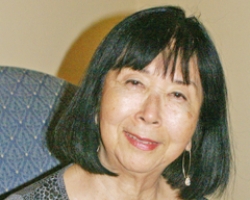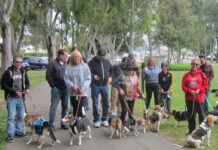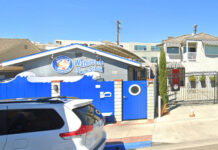“Those who cannot remember the past are condemned to repeat it” wrote George Santayana in 1905.
That was five years before our town was founded, but his statement still resonates just as strongly 110 years later. I know that it does for this week’s Neighbor to Know in ways most of us will never have to consider. It is my honor to introduce you to College Park East neighbor Joyce Nakamura Okazaki.
In April 1942, 7-year-old Joyce, her younger sister, mother, father, and entire extended family of grandparents, aunts, uncles and cousins began what would be a more than two year stay at Manzanar Relocation Center, one of 10 such camps in the U.S that interned more than 110,000 Japanese Americans during World War II. Joyce, her sister and mother were all natur
al born American citizens, and her father was naturalized after arriving at age 11, but the country was at war and abject fear had taken over especially on the West Coast.
Joyce’s parents both held college degrees; her mother was a teacher who took on teaching responsibility at the camp, and her father was an architect, a skill that went unused for the rest of his life, even after their interment ended.
In 1943-44, Ansel Adams came to the camp to chronicle the people and life there. Joyce, her sister and mother are in many of the pictures. He published the book “Born Free and Equal” in 1944, which was not well received. The book and all photographs were given by Adams to the Library of Congress where they can be viewed today.

In late 1944, the family left the camp after signing a loyalty oath required to leave, each given $25 and a one-way ticket to anywhere “outside the Exclusion Zone.” They were not allowed to
return to their home in Los Angeles or anywhere on the West Coast.
Her father chose Chicago where he found work as a draftsman for the railroads. Joyce graduated high school and started college at the University of Illinois Navy Pier. She recalled what many of you already know about Chicago in winter: it is really, really cold, a cold she could never get used to.
In1952, the family came back to Los Angeles, and she transferred to UCLA, where she graduated in 1956 with her B.S. in Business Administration. She shared with me that although sh
e loved UCLA, she experienced segregation and prejudice repeatedly.
It followed her as she began seeking work not only as a Japanese American, but as a woman because every job she applied for, she was expected to take a typing exam even if the job did not require it, and typing was one skill she did not have. In her first job, she found that she was making 20 percent less doing the exact same job as a male co-worker and so she left.
Increasingly frustrated and unable to find work, in 1957 she took the Civil Service exam and was hired to work for the Department of Employment. She started work at the corner of 5th and Flower, fondly recalling riding the streetcars to work. She found the work interesting and quickly learned everything at the division where she worked. A year later, she was mov
ed to an office in Norwalk where she had the opportunity to spend time in Washington D.C. learning in depth about developing occupational codes.
She loved this challenge and worked for almost 13 years doing it.
In 1962, her mother asked her to please go on “one last blind date” she had arranged. Her sister was already married and her mother wished for Joyce to be married too. It was the date that changed the course of her life. James was different from the start. They discovered that James’ family had also been at Manzanar at the same time, and only one block unit away from them. James was extremely gifted in learning languages and had served in the Korean war as an interrogator for U.S. Military Intelligence. He was an M.I.T. grad in Electrical Engineering and had come to California to be closer to his family, whom had just returned from Japan. It was kismet.
They were married six months after meeting in early1963 and lived near the Watts area of Los Angeles. Joyce vividly recalls the day the Watts riots started in 1965. She was coming home from work and as she drove across Imperial Highway, she witnessed people being dragged from their cars and cars being set on fire.
Their son Neil joined their lives in 1970, and Joyce gave up her work to stay home with him. Everyone they knew had moved from the area in the years following the riots, and they decided it was time to move too. They drove to Fountain Valley to look at a new sub-division but found nothing and as they began their drive home, noticed a sign for model homes at the Valley View exit. They got off the freeway and found themselves viewing the model homes that were to become College Park East. They fell in love with them, bought one and in December of 1971 moved to this new Seal Beach enclave to begin the next chapter in their lives on Ironwood where Joyce still lives today, 45 years later.
She recalls watching as the city built Heather Park and wanting a place to push the stroller with Neil so she went to the city and asked if they would put in a sidewalk in and around and they did. Neil attended Los Alamitos schools starting with McGaugh. Joyce served for many years on the PTA and was a volunteer at the Weaver Elementary media center, and then became a substitute instructional aid. She found she loved teaching so she tested for and accepted a media center job in the district in 1985. She continued to work in the LASD for over 1
9 years, serving at McGaugh, Los Alamitos Elementary, and the LAHS before retiring in 2008.
But Joyce is not really retired. She is a devoted and active member of the Manzanar Committee, a nonprofit dedicated to the education of this period in history. She speaks and conducts educational courses as often as possible to civic groups, school students and anyone who requests to learn more about the incarceration of Japanese Americans during the war and why we must never forget. She attends the annual pilgrimage each April back to Manzanar as well.
Joyce is active in the Seal Beach International Friendship Association as well as volunteering at the Los Alamitos Joint Forces Training Base. She still practices with a taiko group regular
ly and has an active grandson who she adores and spends as much time with as possible.
What does she love most about her years in Seal Beach? First, the lifetime friendships she has forged,
especially a small group of women who have all been together for these same 45 years in CPE. Second, the weather.
As others have also said, “Why do I need to go anywhere else when I have this?”
For Joyce and the others who lived this story, the most important message is this: “Our civil rights as Americans are imperative. We should all know them and we are all bound to guard them.” I can personally say that having had the honor to share her story, it is something I will never take for granted again. Thank you Joyce for sharing your journey with me.
If you would like to know more about the Manzanar Committee you can visit: manzanarcommittee.org.
If you would like to see Ansel Adams’ work at Manzanar go to: loc.gov/pictures/search/?sp=3&co=manz&st=grid/












